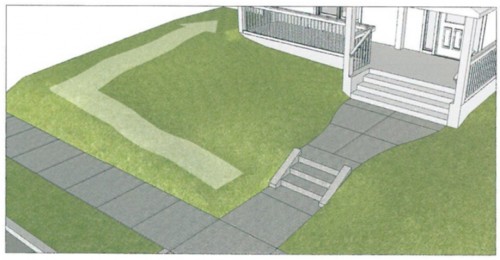 Designs that are easiest for the disabled to navigate can benefit all users.Illustration from Inclusive Design: A Pattern BookLast weekend, I decided to initiate a little test on my walk home from downtown. I was pushing my daughter in a stroller, and I wondered if I could make it all the way without lifting the wheels off the ground. Our pedestrian mall funneled us through a tunnel under a busy road and back up a nicely landscaped path to merge with the sidewalk again. So far so good. But eventually the sidewalk abruptly ended with a ledge, and I had to lift the stroller onto the street. We crossed to the other side only to find no curb cut there either. After narrowly dodging a few telephone poles and hopping on and off the sidewalk several more times, we reached our house. There, we had to break the rules again to make another leap up to the side door. Mission not accomplished.
Designs that are easiest for the disabled to navigate can benefit all users.Illustration from Inclusive Design: A Pattern BookLast weekend, I decided to initiate a little test on my walk home from downtown. I was pushing my daughter in a stroller, and I wondered if I could make it all the way without lifting the wheels off the ground. Our pedestrian mall funneled us through a tunnel under a busy road and back up a nicely landscaped path to merge with the sidewalk again. So far so good. But eventually the sidewalk abruptly ended with a ledge, and I had to lift the stroller onto the street. We crossed to the other side only to find no curb cut there either. After narrowly dodging a few telephone poles and hopping on and off the sidewalk several more times, we reached our house. There, we had to break the rules again to make another leap up to the side door. Mission not accomplished.
I wouldn’t normally be this OCD about stroller convenience, but reading Inclusive Design: A Pattern Book is reorienting my perspective. The good folks at the Center of Inclusive Design and Environmental Access have just published, from what I can tell, the first guide to marrying sustainable urbanism to accessible design. Although my daughter can easily be carried over these obstacles, any disabled person in a wheelchair cannot. This trip would not be possible, nor would buying or renting my home without some serious modifications.
This matters to anyone hoping to encourage authentic urban living options — for a few reasons. We’re living longer and we’ll probably be frail for those last few years. More and more elderly Americans are looking for ways to avoid high-cost institutional living by staying independent in the homes they know. Remember, the baby boomers loom on the edge of retirement like an approaching tidal wave. They’ll want somewhere suitable to age in place.
Most observers believe the movement toward walkable, urban neighborhoods is being driven by two demographics. There’s the younger post-college set for whom the love affair with automobile has fizzled (and they’re not returning the phone calls). Let’s be honest. Many of us who chatter away on the internet have this group in mind, because many of us are this group.
But the other group carries arguably more force to the market. Their kids have left home, and the square footage they once coveted in a house is now just more to clean. The expansive lawn is just more to mow. Eventually, community and security begin to trump privacy. It’s no coincidence that the AARP is one of the strongest proponents for livable communities at all levels of policy and design. These retirees will need accessibility.
But the point of the book isn’t really to convince you of this. It’s to show builders and planners, or really anyone who’ll listen, how to design the urban environment to include those with special needs. The authors make the case that, as long accessibility is in mind from the outset, there’s very little extra cost or aesthetic sacrifice to it. For example, they show that purchasing a 36-inch door from a wholesaler costs only a few dollars more than a 32-inch one, regardless of the regional market. Most of us wouldn’t notice the difference, but a standard wheelchair cannot pass through the 32-inch door. There are dozens of simple design decisions that may be overlooked.
There’s a heavy emphasis on building right the first time. Those awkward ramps up the front steps you sometimes see get no accolades from the authors. Retrofits like these are Band-Aids that only serve to marginalize the homeowner. The better way is to grade up to a zero-step entrance before the house is ever built. Fair enough, but those of us who can only work with the template we’ve been given can feel a little left out while reading. The section on neighborhood design includes great advice on connecting blocks to allow easy walking routes, but it’s addressed to those “laying out a new neighborhood.” These are the days of adapting and transforming what we already have. Sequel, maybe?
Back to my daughter in her stroller. The point driven home by Inclusive Design is that placemaking for those with the greatest needs will benefit all of us. The bollards guarding the sidewalk from vehicular traffic protect the blind man and the distracted pedestrian on his cell phone alike. A graded entry up to a home is handy when you’re pushing a couch on a dolly. So are wider doorways. And, sure, I’ll survive lifting the wobbly stroller wheels off the ground, but I’d take the nicely graded path any day.



